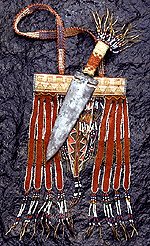 |
Northern Ojibwa type, ca. 1750; Speyer Collection CMC III-D-568 a,b
knife: iron, wood, porcupine quills, skin thong, glass beads, woollen yarn; 29.5 cm. long
sheath: wood, tanned skin, porcupine quills, woollen cloth, glass beads; 24 cm. long
The native inhabitants of Canada's eastern subarctic woodlands -- the northern Ojibwa and Cree Indians -- traditionally wore garments of animal skin decorated with porcupine quills, paint and fringes. They dressed their hair with ochre, grease and feathers, painted and tattooed their faces, and suspended ornaments of bead, shell and bone about their bodies.
The knife sheath shown here was part of this distinctive complex of native dress and adornment. It is a fine example of early artistic traditions and of the technical skills of the women who made them. The presence of imported materials -- iron, trade cloth and glass beads -- on otherwise traditional items suggests that these pieces were made soon after contact with Europeans, possibly during the late eighteenth century. An iron knife was a much-coveted trade item. The Native owner of this one encased it in an elaborately decorated sheath, and carried it ostentatiously displayed on his chest.
Traditional eastern subarctic styles of clothing and adornment changed rapidly following exposure to European goods, technologies and fashions. Artifacts such as this are rare and irreplaceable souvenirs of a rich and complex aboriginal culture.
|

